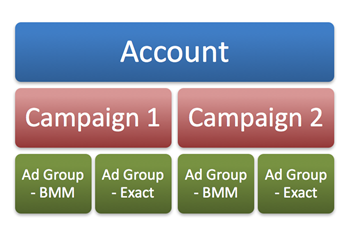If you are ever told that the goal of an ecommerce account isn’t to improve ROI, you are probably being lied to. Generating more revenue is the driving factor behind the majority of businesses and the marketing efforts they push. It may not be the be-all end-all with other goals such as newsletter sign-ups and calls, but it’s vital.
How can you improve ROI? If the answer was simple, we’d all be rich. Every account is different and some tactics that work for one account may not work for another. That being said, below are 3 tips to get you on the right track to success.
1. Improve Account Structure
Account structure can either make or break an account. From the way the campaigns are segmented to the match types being used in each ad group, it’s important. You want to stay organized to easily accommodate for future builds and stay efficient to increase CTR and reduce CPAs.
Staying organized is first and foremost. If you are in a room that has items scattered throughout, it’s impossible to know where anything is and to know where to place new items that make the most sense. It’s the same in your account. Make sure that campaigns and ad group have fluid themes (and names, but that’s for another blog post) that align with the site.
Once you are organized by themes, segmenting by match type at either the ad group or campaign level will give you additional benefits. These include but aren’t limited to:

- Better control when it comes to search queries matching to keywords and the ad copy being displayed to users.
- The use of embedded negatives to direct keywords to the appropriate ad group.
- The ability to control budgets and adjust based on performance at the campaign level.
While this may be beneficial to some, there is some debate on what the actual impact of segmenting by match type is. Below are three articles to get your brain moving.
- Here’s Why You Should Separate Match Types By Ad Group (Kirk Williams)
- The Argument For Match Type Segmentation (Amanda West-Bookwalter)
- Segmentation by Keyword Match Type: A Case Study (Rachael Law)
2. Reduce Non-Converting Spend
This is a quick, yet effective move. Regularly perusing your account for keywords that just aren’t driving conversions is a sure way to improve ROI if you maintain revenue. While I’m not going to go into a tutorial on how to do this, there are a few tips to keep in mind when determining if something is worth pausing.
- Look out for click assisted conversions. While they aren’t direct conversions, they play a role in the overall flow.
- Sometimes looking at a longer date range will paint a bigger picture. When looking at a 30-day window you may see that a relevant keyword has only spent $20 and hasn’t converted so you keep it because of its relevancy. However, when looking at a 6-month period of time you realize that it’s spent $300 and hasn’t converted. Imagine if you have just 10 keywords that haven’t converted in 3 months. You have now spent $3k on 10 keywords that gave you $0.
- Don’t forget to look at search queries. A keyword might be bringing in conversions but what does the traffic behind the keyword look like? Here is a great article on Non-Converting Cost %: Illuminating Trends in Your Account (Jacob Fairclough), that walks through looking at non-converting spend at the search query level.
3. Utilize Remarketing Lists For Search Ads (RLSA)
This is another quick yet effective move. Remarketing Lists for Search Ads (RLSA), are audience lists that can be layered on search campaigns to target those within your remarketing lists. If you are unfamiliar with RLSA, check out this article.

Once set-up, RLSA lists can help improve ROI. With RLSA audiences, we have the ability to increase bids for users who are more likely to convert than your average Joe on the street who has never heard of your brand. This gives you the ability to potentially bid down across your Search campaign as a whole but bid higher on audiences more likely to convert.
Conclusion
While the tactics above may not be game changers and may be considered elementary, they could be the quick win you need to improve ROI.




